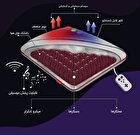Iranian Scientists Improve Polyelectrolyte Network to Optimize Fuel Cell Production

“The lack of a comprehensive study of the main process of small molecule penetration like water, ions and fuel (generally methanol) in polyelectrolyte systems (ion exchange membranes) used in fuel cells and water purification membranes, and the structural parameters of the polyelectrolyte network on this process prompted us to conduct more precise studies in this field,” said Mohammad Ja’afar Rezayani, a PhD student and the manager of the research.
“The main reason for this lack of laboratory devices is the inability to observe the details of the permeation process and the effect of the structural parameters of the polyelectrolyte network on the permeation process on a molecular scale, which can be determined by using the molecular dynamics simulation tool of the parameters affecting this process, including the effect of the structural parameters of the network. In this study, polyelectrolyte on permeation process was investigated with molecular precision,” he added.
Noting that the molecular dynamics simulation tool examines various physical and chemical processes on a molecular scale, Rezayani said, “By understanding the parameters affecting the diffusion process on a molecular or microscopic scale, the behavior of the system can be predicted on a large or macroscopic scale.”
“In this research, in addition to the formation of water channels and the investigation of structural parameters affecting the process of small penetration of the aforementioned molecules, we were able to establish a quantitative relationship between the main structural parameters of the polyelectrolyte network that determine the penetration behavior and the small penetration coefficient of molecules by using a simulation tool for molecular dynamics,” he explained.
Fuel cells work like batteries, but they do not run down or need recharging. They produce electricity and heat as long as fuel is supplied.
A fuel cell consists of two electrodes—a negative electrode (or anode) and a positive electrode (or cathode)—sandwiched around an electrolyte.
4155/v
























